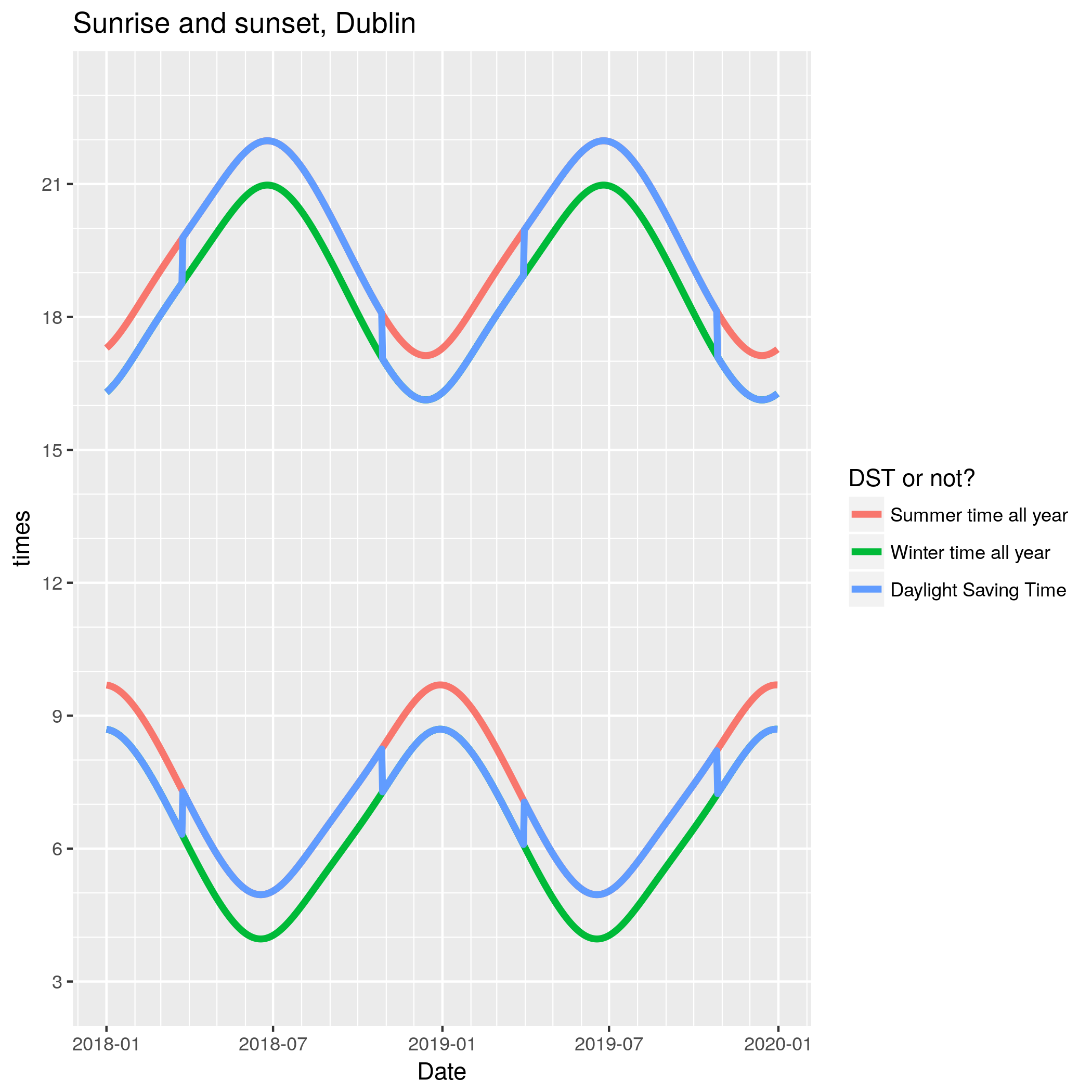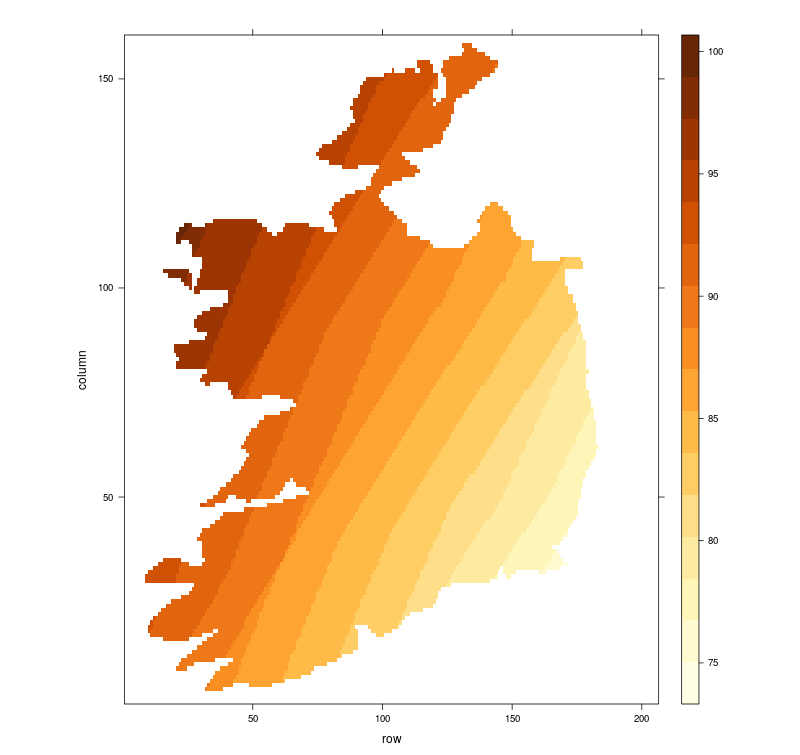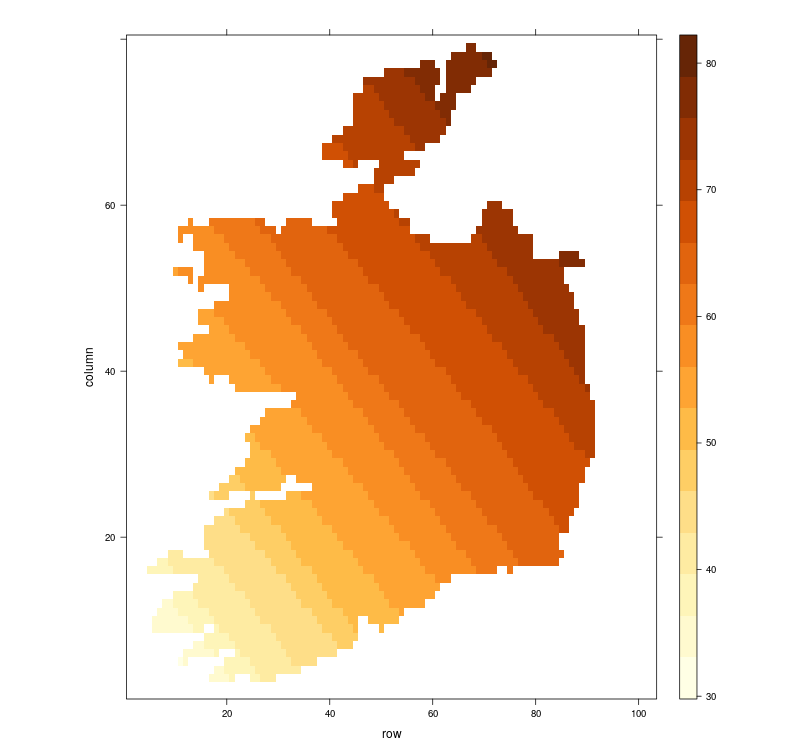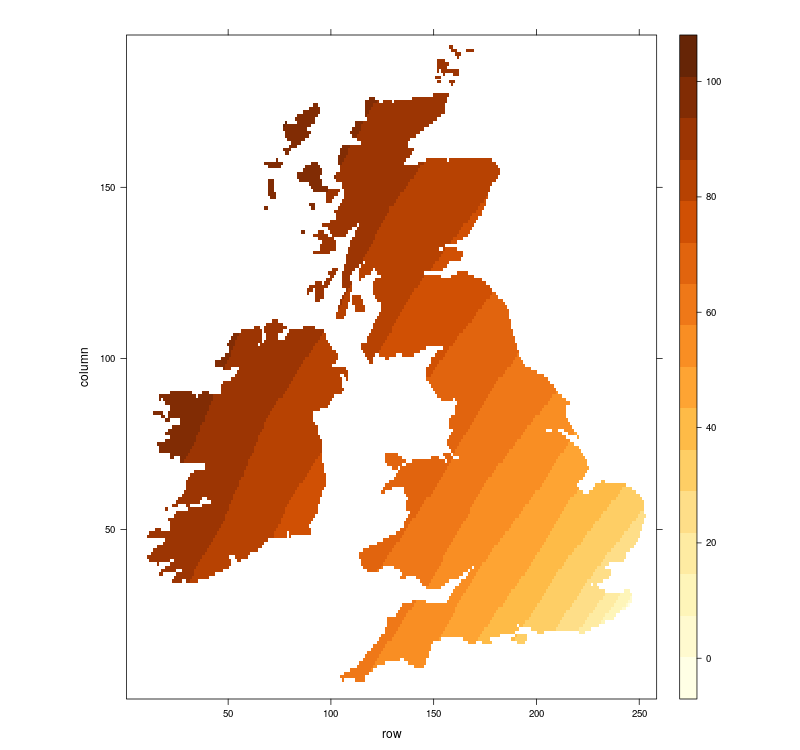Doing away with DST
The European Commission has started making moves to suggest that countries should stop using daylight saving time, and decide on a year-wide timezone. There is a lot of support for this, particularly for a week or so in late October and late March every year.
Yes, the switches are inconvenient, particularly the spring one, where we lose rather than gain an hour’s sleep. But what are the advantages of DST? The gains that persist through the seasons stand out less than the transient annoyance of the switches. The key idea of DST is that in the summer, dawn is so early that we sleep through lots of daylight. Putting the clocks forward in the spring means one hour of this daylight is shifted to the evening. In Ireland this means we’re on GMT (a little ahead of solar time across the whole country, more so in the west) in the winter, and GMT+1 for the summer.
If DST is abolished, we remain on either GMT+0 or GMT+1 for the whole year. I suspect GMT+1 would be favoured, because it keeps us closer to the continent.
The Irish Department of Justice is seeking feedback on the issue until 30 November 2018. Direct feedback form link
If we change to permanent GMT+1
So what would happen? GMT+1 would mean dark winter mornings, and correspondingly brighter evenings.
Look at the chart for Dublin. The blue line shows the current system, the red is what 12-month GMT+1 would look like, and the green is GMT+0. It shows that GMT+0 (or DST) gives about 3 months in the winter with sunset between about 4:10 and 5:00pm. This will be 5:10 to 6pm if we move to GMT+1, which will make the evening rush hour a little brighter. However, the price for that is that for a little more than 2 of those 3 months, sunrise will be between 9:00 and about 9:45pm, meaning that for most people the morning commute will be in the dark.

Figure 1: Sunrise and sunset in Dublin, GMT+0 and GMT+1
Dublin is in the east, so it is not typical of the country as a whole. Elsewhere, times will be mostly a little later. For instance, sunrise and sunset in Tralee are about 20 minutes later than Dublin.
We can map this pattern over the whole country. The number of days with sunrise on or after 09:00 varies from 75 in southeastern Wexford to 99 in Belmullet. Here in Limerick we will have about 87 days per year with sunrise after 9am.

Figure 2: Number of winter days with sunrise after 09:00 under permanent GMT+1
In the table below I summarise what the picture would be like for children going to primary school, counting the number of days with sunrise after 9am, calculated on the coordinates of the school. The extremes are two schools in Wexford with 75, and two in Belmullet with 99 days. But 329 schools in Dublin will have 80 very dark mornings. See also this clickable map with details on individual schools.
| County | <=78 | 79 | 80 | 81 | 82 | 83 | 84 | 85 | 86 | 87 | 88 | 89 | 90 | 91 | 92 | 93 | 94 | 95+ |
|---|---|---|---|---|---|---|---|---|---|---|---|---|---|---|---|---|---|---|
| Carlow | 21 | 3 | 18 | |||||||||||||||
| Cavan | 7 | 2 | 35 | 9 | 19 | 2 | 2 | |||||||||||
| Clare | 7 | 10 | 25 | 26 | 34 | 12 | 1 | |||||||||||
| Cork | 3 | 13 | 48 | 84 | 76 | 35 | 62 | 13 | 7 | 3 | ||||||||
| Donegal | 1 | 3 | 67 | 21 | 54 | 7 | 22 | |||||||||||
| Dublin | 71 | 329 | 40 | |||||||||||||||
| Galway | 4 | 23 | 17 | 62 | 16 | 67 | 3 | 25 | 14 | |||||||||
| Kerry | 2 | 41 | 7 | 67 | 5 | 13 | ||||||||||||
| Kildare | 1 | 65 | 24 | 12 | ||||||||||||||
| Kilkenny | 16 | 3 | 40 | 4 | 11 | |||||||||||||
| Laois | 8 | 3 | 37 | 15 | 3 | |||||||||||||
| Leitrim | 11 | 4 | 9 | 9 | 6 | |||||||||||||
| Limerick | 17 | 6 | 75 | 5 | 34 | 2 | ||||||||||||
| Longford | 10 | 3 | 25 | |||||||||||||||
| Louth | 47 | 6 | 18 | |||||||||||||||
| Mayo | 32 | 7 | 50 | 78 | ||||||||||||||
| Meath | 20 | 34 | 23 | 33 | 3 | |||||||||||||
| Monaghan | 20 | 2 | 29 | 10 | 1 | |||||||||||||
| Offaly | 9 | 10 | 26 | 17 | 3 | |||||||||||||
| Roscommon | 1 | 29 | 8 | 39 | 2 | 12 | ||||||||||||
| Sligo | 3 | 33 | 19 | 9 | 3 | |||||||||||||
| Tipperary | 11 | 2 | 49 | 9 | 51 | 11 | 27 | |||||||||||
| Waterford | 2 | 28 | 8 | 27 | 5 | 4 | ||||||||||||
| Westmeath | 11 | 17 | 31 | 8 | 5 | |||||||||||||
| Wexford | 82 | 21 | ||||||||||||||||
| Wicklow | 37 | 29 | 14 | 3 |
Source: Department of Education, with thanks to Eoin O’Mahony
If we change to permanent GMT+0
While permanent GMT+1 would keep us closer to continental time, it puts us a lot further ahead of the sun. We are already quite far west from the Greenwich Meridian, which is the natural centre-line for GMT+0. The main advantage of GMT+1 would be brighter winter evenings, as mentioned above. The main disadvantage of GMT+0 all year would be that in early summer we would be sleeping through rather a lot of daylight. As the chart for Dublin shows, GMT+0 gives about three months of dawn before 05:00, and a month with it at or shortly after 04:00. We currently ship an hour of this daylight into the evening, without affecting winter mornings.
The map below shows the number of days with sunrise before 04:30 under permanent GMT+0. This varies between 33 days in west Kerry and 79 in Donegal, but it is also quite high in the populous east.

Figure 3: Number of summer days with sunrise before 04:30 under permanent GMT+0
We’re west and north
There is a strong push to abolish the practice of changing the clock across Europe. In Ireland we are relatively far north, so we benefit more from the practice (day length changes more than further south). We are also quite far west within our timezone (the “natural” span for GMT should be from 7.5° East to 7.5° West; Ireland is between 5.4° and 10.6° West). Being to the west makes us much more affected by late sunrise. (See a final map which shows the UK and Ireland: the number of days with sunrise after 09:00 is zero in the extreme southeast of England, and as high as 101 in the Hebrides; Ireland’s westerliness and Scotland’s northerliness mean GMT+1 affects them similarly).

Figure 4: Winter days with sunrise after 09:00 under permanent GMT+1, UK and Ireland
Decision time is coming
Thus if we shift to permanent GMT+0, we’ll lose late evening light in early to mid summer. If we shift to GMT+1, we will have two to three months of miserably dark mornings.
Personally I think the inconveniences of switching are outweighed by the advantages, but I hope this information helps you make your mind up.
Department of Justice feedback (until 30 November 2018): information and direct feedback form link.
I recall this proposal GMT+1 being used for 2 years when I was in primary school in Scotland (late 1960’s or early 1970’s). It was abandoned after 2 years because many children were travelling to school in darkness. Overall it was a complete disaster. We need to learn our lessons from the past or learn from others who have tried this before.
I remember the same thing, which happened here around 1969 (we followed the UK’s lead). My key memory is that the government issued every kid with a reflective armband (in those days everyone walked to school).
Eliminate it. Or , a compromise would be to reduce the winter tine period to December, January, February